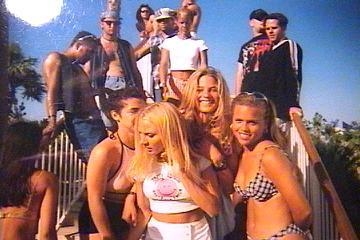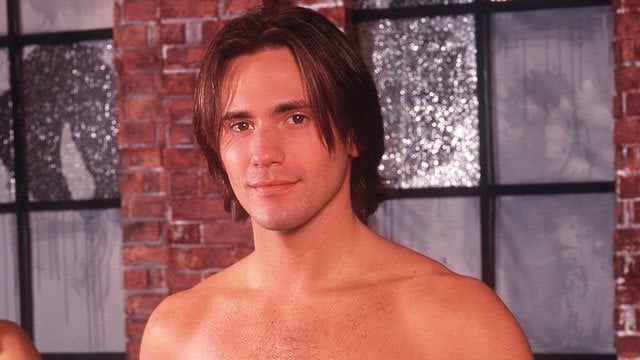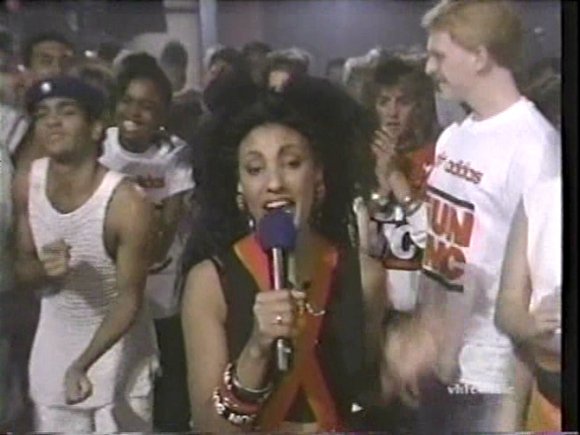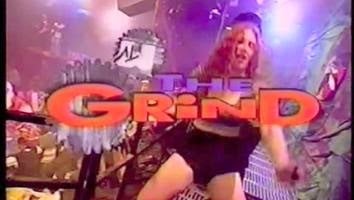MTV’s The Grind was Important to Me – Here’s Why I Want It Back
The World Still Needs The Grind, or Why Pre-Millennial Dance Shows Were A Weird Kind Of Spiritual Experience For Me.
Those pre-millennial dance shows: there seems something slightly sinister (or maybe just lightly unnerving) about them now.
At least to me.
At least after thinking about them over the past few weeks. Something sinister, something darkly awkward (like Patrick Swayze in Donnie Darko) – especially the Club MTV era and the holdover of its aesthetic during the first years of The Grind. The shift of musical genre from hip-hop/pop to EDM, yet a set that changed very little of the warehouse ambience of its 80s predecessor.
Maybe I feel this way because it reminds me of a scene from American Psycho? Maybe the aggressive thrusts of men in parachute pants is off-setting to me for some reason yet-to-be uncovered by my therapist? Or maybe it’s because the whole set-up seemed like the desperate attempts of some Dionysian muse or god to hold onto whatever bacchanalia original produced this whole mess. Whatever spirit was appeased saw that the time of choreographed team dancing, random outbursts of breakdancing and high-waist jeans and fly boys and girls wearing pajamas pants and tops was reaching its end.
Maybe it’s not the idea of the dance shows of the ‘80s and ‘90s that I find sinister though. Maybe it’s the longing I have for dance shows and what I think they represented. Maybe the sinister element, for me, is whatever in the culture that propagated their dissolution.
I write because there’s been a push, ever since the show went off the air almost ten years ago, to bring it back in DVD form. People want to see it. Some of those people would like it to return to air, too. I myself am included. Why? Why the hell do I want to ever see this show again?
Vicarious Freaking

Nostalgia is a big part of the desire to bring back dance shows on MTV, but what place did they serve and why was it eliminated? Did it not fit the generation anymore? Do dance shows and music videos have some sort of tragic karmic link, some shared ennui that the current flock of MTV viewers absolutely refuse to endure?
I’m old and so I don’t understand this. After all, what could be better than a dance show?!
Shows like The Grind and its predecessor Club MTV were first and foremost about vicarious experience. Most of the people who want The Grind back or any dance show always talk about how THEY wished, when they were 9 or 15 or 20 or whatever, that they could’ve been dancing at the Palladium in NYC or on the roof of MTV studios set up to look like some reflector vest-themed resort in some undisclosed location in Florida.
In a similar way, that’s what shows like American Bandstand and Soul Train were about. People enjoyed seeing other people dance to the latest music. The increasing seclusion of individualism that the internet’s increasing infinity of options provides has allowed for any one person to create a world specifically tailored to their desires and experience the cool that they were already expecting in the exact form that they were anticipating. If that means the latest iMac EDM sensation coming somewhere out of Brooklyn then so be it. If it that means listening to the serotonin-inducing alt rock of the mid-90s then so be it. If it means top 40s radio, then have at it. It’s yours.
Antidote to Solipsism
There was something different, something heightened about the participatory nature of shows like Bandstand, Soul Train and their MTV scions Club MTV and The Grind. The mission of Bandstand and Soul Train was the collective agreement of those teen and 20-something viewers that THIS is what WE love. It seems manipulative now, perhaps – however, that sort of cynicism comes from an age in which the almost infinite number choices presented to the viewer means that the viewer becomes less than they were. They become solipsistic. To put it another way, they look up their own asshole for fun and entertainment. And eventually they’re a prisoner to the own rectal aperture.
If anyone has ever known someone who was up their own asshole, then you know how hard it is to tear them away from it.
Now, these dance shows played the latest music and showed you how to dance to it. They showed you how to go out there in the real world (no pun intended) and jiggle your body in the social sphere with other denizens of your age group. A real group consciousness was generated there.
With the advent of MTV, the addition of music videos played simultaneously to the action meant that the visual sphere was heightened. TVs in the studio showed the video that viewers saw intermittently with the crowd of people dancing. Mass collectivity that transcended spatio-temporal barriers. There was an ecstatic immanence to the experience, a present-ness to social experience that’s difficult to maintain now without people turning their eyes to the hypnotizing glare of a smartphone. (In fact, maybe it’s too intense. Maybe we’ve become far more sensitive to social interaction so that we can only take it in one or two minute gulps.)

VJs emceed lightly. They were not separate from the action. Unlike MCs on Soul Train or Bandstand who stood outside the action and seemed to administrate it, VJs were neck deep in the throes of it all. The space, at least the darkened studio of Club MTV gave a sense that they were trapped in the party. They couldn’t get out. Downtown Julie Brown held a considerable distance from the action, always finding an open spot to introduce a musical guest or new song. But once the show evolved to Eric Nies, he actually engaged in dancing. He loosely administrated things. Seeming to always be tearing himself away from the action to talk to the viewer. Most of the time, he seemed to be high on MDMA – but that’s beside the point. People seemed legitimately enthused. It was, actually, incredible and enlivening to watch such a show.
Who had control? You weren’t sure.
Get your otium here
Nies was phased out eventually and when he was there was no stable persona after that. Guest hosts frequented the show, but the truly lasting impression of The Grind (and the one that I will always remember it by) is the outdoor studio featured in the summer months. The Grind was paired with MTV Spring Break in this sense, but shared none of its more decadent features.

Club MTV (which had originally been intended as a family show but the abundance of skin-tight outfitted ladies with cleavage that could crush a walnut quickly established it as an underground and a production predilection for upskirt shots) had established itself unwittingly as an adult program. The Grind, however, gravitated back toward more family-friendly programming: less boob-age and crotch shots and more dancing. The music, which had been moving steadily toward hip hop and rap in the latter year of Club MTV and eventually a cocaine-induced Alan Parsons style of EDM as transitioned to the show’s next incarnation, evolved on The Grind into mainly House and Trance music.
It’s easy to understand why House and Trance would be shied away from in the 80s, what with the coke boom and the warehouse aesthetic of the studio – people would just assume there were business men snorting angel dust in the bathroom and girls flouncing through the club with brains wired on E (again, I can’t get away from the startling connections I’m making to American Psycho). Maybe that’s just me, but it seems like an obvious decision.
When The Grind became more securely fastened to the Spring Break party scene (although not the lascivious True Life spring break shenanigans) of youthful energy and fun, twins in matching outfits doing team dances and groups doing shimmying in a centipede-like form with loose but not too sexy outfits on AND you start doing shows outdoors – well, Trance takes on a different feel. House becomes something spiritual, something uplifting. The space becomes less of a subterranean holdout of humanity’s last enjoying their final days and more of an otium from all that the world (MTV included) pushes on the viewer.
The group dancing created an emotional collectivity. If you were to ask any of the people there, they probably would’ve gone doe-eyed if you suggested that they were part of a community. Or said that they were just dancing. But the beauty of this show was that it presented a community at the margin. A community that was always coming together but never congealed in the way we think of other forms of communal experience (religious, political or a revolutionary). It wasn’t pushing anything, but something was coming from the periphery. A form was taking place and just when it might bring things together the music stopped or camera cut away to cutting remarks by one of the innumerable guest hosts (some of whom, like Dave Chappelle, seemed to lightly mock the very idea of show).
No Real World (literally and figuratively) that awkwardly attempts to create real social situations (but fails miserably as much of the situations are heavily constructed). No Beavis and Butthead requiring the viewer to embrace idiocy as a kind of cynicism toward an incomprehensible world.
It’s okay to dance and enjoy yourself. Words, understandably, are few on the show.
The World Needs The Grind

Maybe that’s what people want. A community self, a community persona that doesn’t just rely on a single person’s emotional and intellectual reservoirs to navigate the world.
For all the beauty that individualism has given Western society (and American culture, in particular), it has also cut people off from the thrill of a sudden group happening. People in the West will not have an Arab Spring, they’ll not have a Berlin Wall. Politically, things, at least in America, have become so blasé and apathetic that engaging in a little group free-for-fall (even vicariously) might be therapeutic. After all, being an individual is really hard. The darkness creeps in. We’re connected to the whole world and many of us have never felt so lonely, or so manic about the schizophrenic search for constant companionship while dogmatically asserting the primacy of myself and my ideas and my wants and needs.
The world needs The Grind. If for nothing else, then our own well-being.
And maybe for a little team dancing, too.

